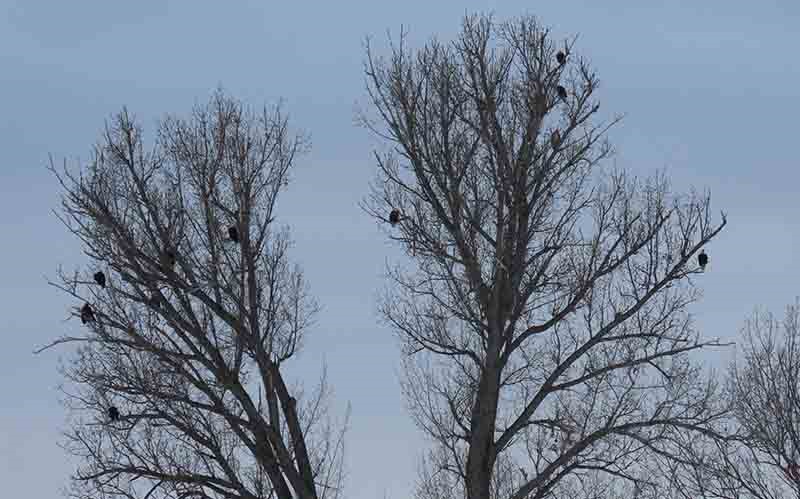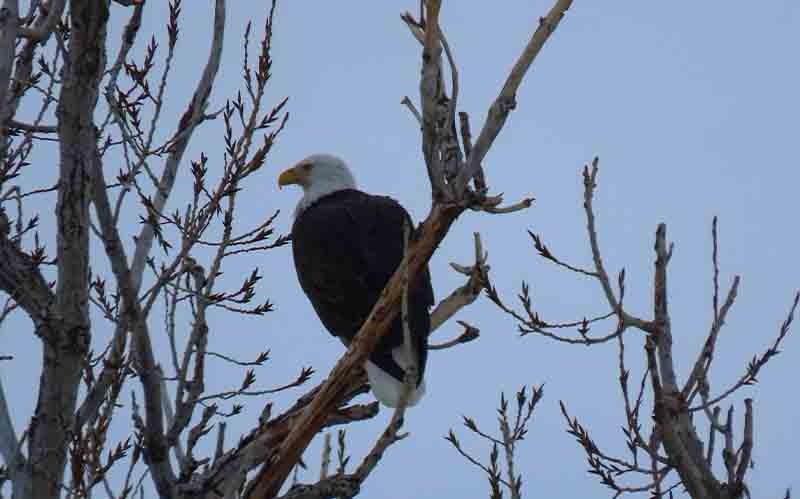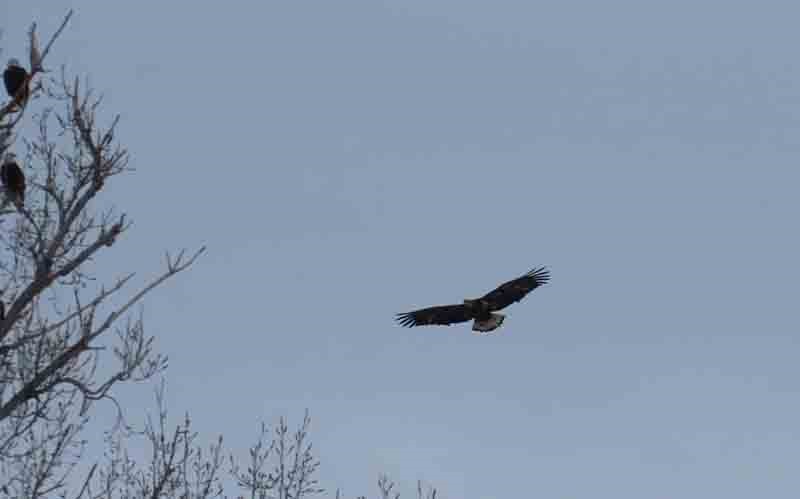|
STORY AND PHOTOS BY KAREN BOSSICK The first bald eagle appeared in the west about 4:30 on a grey winter afternoon. It glided towards a clump of tall cottonwood trees standing in freshly fallen snow and took its perch, wrapping its four two-inch toes around a branch. Within minutes others appeared, greeting one another with a brief chitter chatter. These are the residents of “The Eagle Tree” or “The Bald Eagle Tree” of Southern Idaho. And they’ve been providing evening entertainment for dozens of Idahoans eager for something to do during the Year of the Pandemic
|
|

Bald eagles, whose name comes from the old English word “balde,” which means “white-headed,” begin to take up residence on one of a handful of cottonwoods they use.
|
|
|
No one knows which Realtor sold them on Eagle’s Landing, as the neighborhood three miles west of Wendell might be called. Likely, it was the Snake River Canyon, which sits 2.5 miles away and provides fresh fish for the taking. And, likely, the surrounding farmland that they can easily keep watch over from their perch was a big selling point, as well. They’ve been coming here for about 15 years. Only a few came at first. But the population climbed to 60 within a few years, according to Paul and Rosemary Azevedo, who own the organic dairy farm the cottonwoods sit on. The Azvedos say they counted 250 in 2017 when southern Idaho was buried in snow. But this year the bird count has averaged about 80.
|
|

One bald eagle makes his presence known.
|
|
|
They typically begin arriving in October, peaking in January and February. They stay into March during cold winters. The best time to see them is at sunrise and sunset. They take off from their perch as the skies begin to lighten to search for food, their eyesight three to four times better than humans. They begin returning just before sunset since they don’t possess the nocturnal eyesight of owls. Those who flock to see the birds perched on the naked branches of the cottonwood trees are awed by the majesty of the birds, which stand 30 inches tall and boast a wingspan up to eight feet.
|
|

Bald eagles, endangered during the 1970s, lay one to three eggs, which take a month to incubate. They nest between 56 and a hundred days.
|
|
|
“They’re huge and so impressive when flying,” said Hailey birder Poo Wright-Pulliam. “And seeing 200 eagles gather at night to roost in the trees and on farm sprinklers is amazing. Bald eagles are often thought of as solitary birds, but they can be communal at this time of the year.” Bald eagles boast 7,200 feathers at maturity. Immature eagles resemble golden eagles as they are brownish with white flecking on their bellies and under their wings. This coloring may help camouflage them when they’re less able to flee from predators. As they approach their third year, their throat and belly turns paler and their beak begins to turn yellow-brown. They gain their trademark white head and tail towards the end of their fourth year or the beginning of their fifth. Their two-inch yellow beak is monstrous, said Wright-Pulliam. It’s able to slice through prey and tear meat.
|
|

Bald eagles can fly 20 to 30 miles an hour.
|
|
|
Their tongues are short so they can’t bite them. But each has two barbs with which they can pull food items to the back of their mouths. One thing that surprises viewers is their call. Far from being the powerful call you might imagine, it’s real high-pitched, short and wimpy, said Wright-Pulliam. “Squeaksqueaksqueaksqueak,” she said. In fact, it’s so unbefitting for a bald eagle that TV documentarians have substituted red-tail hawk calls for bald eagle calls, she added.
One recent night at the Eagle Tree, the residents seemed to be having a heyday spotting voles or rabbits a mile away in a field across West Point Road. Every once in awhile one would leave its perch to fly over the onlookers standing alongside the road and swoop down flying low to the ground as they snatched a critter with their talons. They ate their take as they returned to roost. Occasionally, lucky observers are treated to a show of courtship in which a couple eagles fly high in the sky, locking their talons and cartwheeling downward together. They break apart just before they hit the ground. While bald eagles do not build homes in the cottonwood trees near Wendell, they have built a nest on a cottonwood tree near a ditch at the east entry to Silver Creek Preserve near Bellevue. Eagles are known to build some of the largest of all bird nests, measuring five to six feet in diameter and standing two to four feet high.
“They’re monstrous stick nests that they add to each year,” said Wright-Pulliam. “Their nests can weigh up to two tons. In fact, some get so heavy they cause trees to come crashing down.” The female, which is larger than the male, does most of building, weaving together sticks and filling in cracks with grass and cornstalks. They line the nest with material like downy feathers. The nests can take up to three months to build and they add to them year after year. It’s believed eagles can carry half of their weight, judging by some of the items that have been found in their nests. Ketchum residents David and Jill Hitchin are among the Wood River Valley residents who have gone to see the Eagle Tree this month, choosing to do so on a holiday when they feared Galena Lodge would be overrun with skiers.
“We’re very lucky to have the trees close enough to visit,” David Hitchin said. “It was amazing to see the feral cat stalking voles at sunset in plain view of the eagles. And the ducks were a bonus—thousands of wintering ducks, geese and swans at the Hagerman Wildlife Refuge.” The Eagle Tree is located just north of Box Canyon State Park near the West Point roadside café. Residents ask that viewers be respectful and quiet so as not to make the eagles uncomfortable.
|